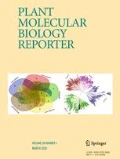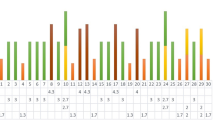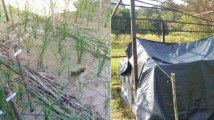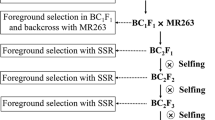Abstract
Rice blast caused by the fungus Magnaporthe oryzae is one of the most devastating diseases of rice in nearly all rice growing areas of the world including Malaysia. To develop cultivars with resistance against different races of M. oryzae, availability of molecular markers along with marker-assisted selection strategies are essential. In this study, 11 polymorphic simple sequence repeat (SSR) markers with good fit of 1:2:1 ratio for single gene model in F2 population derived from the cross of Pongsu seribu 2 (Resistant) and Mahsuri (Susceptible) rice cultivars were analysed in 296 F3 families derived from individual F2 plants to investigate association with Pi gene conferring resistance to M. oryzae pathotype. Parents and progeny were grouped into two phenotypic classes based on their blast reactions. Chi-square test for the segregation of resistance and susceptibility in F3 generation fitted a ratio of approximately 3:1. Association of SSR markers with phenotypic trait in F3 families was identified by statistical analysis. Four SSR markers (RM413, RM5961, RM1233 and RM8225) were significantly associated with blast resistance to pathotype 7.2 of M. oryzae in rice (p ≤ 0.01). These four markers accounted for about 20% of total phenotypic variation. So, these markers were confirmed as suitable markers for use in marker-assisted selection and confirmation of blast resistance genes to develop rice cultivars with durable blast resistance in Malaysian rice breeding programmes.



Similar content being viewed by others
References
Akagi H, Yokozeki Y, Inagaki A, Fujimura T (1996) Microsatellite DNA markers for rice chromosomes. Theor Appl Genet 93:1071–1077
Akama Y (1978) Study on rice breeding technology. A report on TARC/MARDI project 1976–78, Malaysia
Baraket G, Chatti K, Saddoud O, Abdelkarim AB, Mars M, Trifi M (2011) Comparative assessment of SSR and AFLP markers for evaluation of genetic diversity and conservation of fig, Ficus carica L., genetic resources in Tunisia. Plant Mol Biol Rep 29:171–184
Bonman JM, Khush GS, Nelson RJ (1992) Breeding rice for resistance to pests. Annu Rev Phytopathol 30:507–528
Campoy JA, Ruiz D, Egea J, Rees DJG, Celton JM, Martínez-Gómez P (2011) Inheritance of flowering time in apricot (Prunus armeniaca L.) and analysis of linked quantitative trait loci (QTLs) using simple sequence repeat (SSR) markers. Plant Mol Biol Rep 29:404–410
Cantrell RP, Reeves TG (2002) The rice genome: the cereal of the world’s poor takes center stage. Science 296:53
Filippi MC, Prahbu AS (2001) Phenotypic virulence analysis of Pyricularia grisea isolates from Brazilian upland rice cultivars. Pesquisa Agropecuária Brasileira 36:27–35
Fjellstrom R, Conaway-Bormans CA, McClung A, Marchetti MA, Shank AR, Park WD (2004a) Development of DNA markers suitable for marker assisted selection of three Pi genes conferring resistance to multiple Pyricularia grisae pathotypes. Crop Sci 44:1790–1798
Fjellstrom R, Conaway-Bormans CA, McClung AM, Marchetti MA, Shank AR, Park WD (2004b) Development of DNA markers suitable for marker assisted selection of three Pi. Genetics 138:1251–1274
Fjellstrom R, McClung AM, Shank AR (2006) SSR markers closely linked to the Pi-z locus are useful for selection of blast resistance in a broad array of rice germplasm. Mol Breed 17:149–157
Hittalmani S, Parco A, Mew TW, Zeigler RS, Huang N (2000) Fine mapping and DNA marker-assisted pyramiding of the three major genes for blast resistance in rice. Theor Appl Genet 100:1121–1128
Huang N, Angeles ER, Domingo J, Magpantay G, Singh S, Zhang Q, Kumaravadivel N, Bennett J, Khush GS (1997) Pyramiding of bacterial resistance genes in rice: marker-aided selection using RFLP and PCR. Theor Appl Genet 95:313–320
IRRI (1996) Standard evaluation system for rice, 4th edition. The International Network for Genetic Evaluation of Rice, Genetic Resources Center. International Rice Research Institute, Manila, Philippines, 52 p
Jena KK, Mackill DJ (2008) Molecular markers and their use in marker-assisted selection in rice. Crop Sci 48:1266–1276
Khush GS (2005) What it will take to feed 5.0 billion rice consumers in 2030. Plant Mol Biol 59:1–6
Liu G, Lu G, Zeng L, Wang GL (2002) Two broad-spectrum blast resistance genes, Pi9(t) and Pi2(t), are physically linked on rice chromosome 6. Mol Gen Genomics 267:472–480
Liu SP, Li X, Wang CY, Li XH, He YQ (2003) Improvement of resistance to rice blast in Zhenshan 97 by molecular marker-aided selection. Acta Bot Sin 45:1346–1350
Liu XQ, Wang L, Chen S, Lin F, Pan QH (2005) Genetic and physical mapping of Pi36 (t), a novel rice blast resistance gene located on rice chromosome 8. Mol Gen Genomics 274:394-40
Mackill DJ, Bonman JM (1992) Inheritance of blast resistance in near-isogenic lines of rice. Phytopathology 82:746–749
Mallikarjuna SBP, Sarla N (2010) Meta-analysis of yield QTLS derived from inter-specific crosses of rice reveals consensus regions and candidate genes. Plant Mol Biol Rep doi:10.1007/s11105-010-0274-1
McCouch SR, Kochert G, Yu ZH, Wang ZY, Khush GS (1988) Molecular mapping of rice chromosomes. Theor Appl Genet 76:815–829
McCouch SR, Temnykh S, Lukashova A, Coburn J, DeClerck G, Cartinhour S, Harrington S, Thomson M, Septiningsih E, Semon M, Moncada P, Li J (2001) Microsatellite markers in rice: abundance, diversity, and applications. In: Khush GS, Brar DS, Hardy B (eds) Proceeding of the 4th international rice genetics symposium. Rice genetic IV, IRRI-SPI, pp. 117–135
McCouch SR, Teytelman L, Xu Y, Lobos KB, Clare K, Walton M, Fu B, Maghirang R, Li Z, Xing Y, Zhang Q, Kono I, Yano M, Fjellstrom R, DeClerck G, Schneider D, Cartinhour S, Ware D, Stein L (2002a) Development of 2240 new SSR markers for rice. DNA Res 9:199–220
McCouch SR, Teytelman L, Xu Y, Lobos KB, Clare K, Walton M, Fu B, Maghirang R, Li Z, Xing Y, Zhang Q, Kono I, Yano M, Fjellstrom R, DeClerck G, Schneider D, Cartinhour S, Ware D, Stein L (2002b) Development of 2240 new SSR markers for rice. DNA Res 9:199–220
Narayanan NN, Baisakh N, Vera Cruz CM, Gnanamanickam SS, Datta K, Datta SK (2002) Molecular breeding for the development of blast and bacterial blight resistance in rice cv. IR50. Crop Sci 42:2072–2079
Ribaut JM, Hoisington D (1998) Marker-assisted selection: new tools and strategies. Trends Plant Sci 3:236–239
Ronald LP, Vasil IK (1994) Mapping population. In: DNA-based markers in plants ed. by PHILIPS RL, VASIL IK, pp.16
SAS Institute (1989) SAS/STAT user’s guide, version 6, 4th edn., vol 1 and 2. SAS Institute, Raleigh, N. C.
Sharma RC, Chaudhary NK, Ojha BR, Joshi BK, Pandey MP, Tiwary AK (2005) Genetic diversity and performance of Masuli and its substitute rice cultivars. J Inst Agric Anim Sci 26:21–30
Swapna M, Sivaraju K, Sharma RK, Singh NK, Mohapatra T (2010) Single-strand conformational polymorphism of EST-SSRs: a potential tool for diversity analysis and varietal identification in Sugarcane. Plant Mol Biol Rep doi:10.1007/s11105-010-0254-5
Talbot NJ (2003) On the trail of a cereal killer: exploring the biology of Magnaporthe grisae. Annu Rev Microbiol 57:177–202
Temnykh S, Park WD, Ayers N, Cartinhour S, Hauck N, Lipovich L, Cho YG, Ishii T, McCouch SR (2000) Mapping and genome organization of microsatellite sequences in rice (Oryza sativa L.). Theor Appl Genet 100:697–712
Toojinda T, Tragoorung S, Vanavichit A, Siangliw JL, Pa-In N, Jantaboon J, Siangliw M, Fukai S (2005) Molecular breeding for rainfed lowland rice in the Mekong region. Plant Prod Sci 8:330–333
Wang B, Zhu C, Liu X, Wang W, Ding H, Jiang M, Li G, Liu W, Ya F (2010) Fine mapping of qHD4-1, a QTL controlling the heading date, to a 20.7-kb DNA fragment in rice (Oryza sativa L.), Plant Mol Biol Rep doi:10.1007/s11105-010-0278-x
Zhao F, Cai Z, Hu T, Yao H, Wang L, Dong N, Wang B, Ru Z, Zhai W (2010) Genetic analysis and molecular mapping of a novel gene conferring resistance to rice stripe virus. Plant Mol Biol Rep 28:512–518
Zhou JH, Wang JL, Xu JC, Lei CL, Ling ZZ (2004) Identification and mapping of a rice blast resistance gene Pi-g(t) in the cultivar Guangchangzhan. Plant Pathol 53:191–196
Zhou E, Jia Y, Correll J, Lee FN (2007) Instability of the Magnaporthe oryzae avirulence gene AVR-Pita alters virulence. Fungal Genet Biol 44:1024–1034
Zhu M, Wang L, Pan QH (2004) Identification and characterization of a new blast resistance gene located on rice chromosome 1 through linkage and differential analyses. Phytopathology 94:515–519
Zhu W, Lin J, Yang D, Zhao L, Zhang Y, Zhu Z, Chen T, Wang C (2009) Development of chromosome segment substitution lines derived from backcross between two sequenced rice cultivars, indica recipient 93–11 and japonica donor nipponbare. Plant Mol Biol Rep 27:126–131
Acknowledgements
The authors acknowledge technical contributions of Malaysian Nuclear Agency, Molecular Biology Group and Malaysian Rice Research Centre, MARDI, for helpful discussions and greenhouse facilities required for this research.
Author information
Authors and Affiliations
Corresponding author
Rights and permissions
About this article
Cite this article
Ashkani, S., Rafii, M.Y., Rusli, I. et al. SSRs for Marker-Assisted Selection for Blast Resistance in Rice (Oryza sativa L.). Plant Mol Biol Rep 30, 79–86 (2012). https://doi.org/10.1007/s11105-011-0315-4
Published:
Issue Date:
DOI: https://doi.org/10.1007/s11105-011-0315-4




